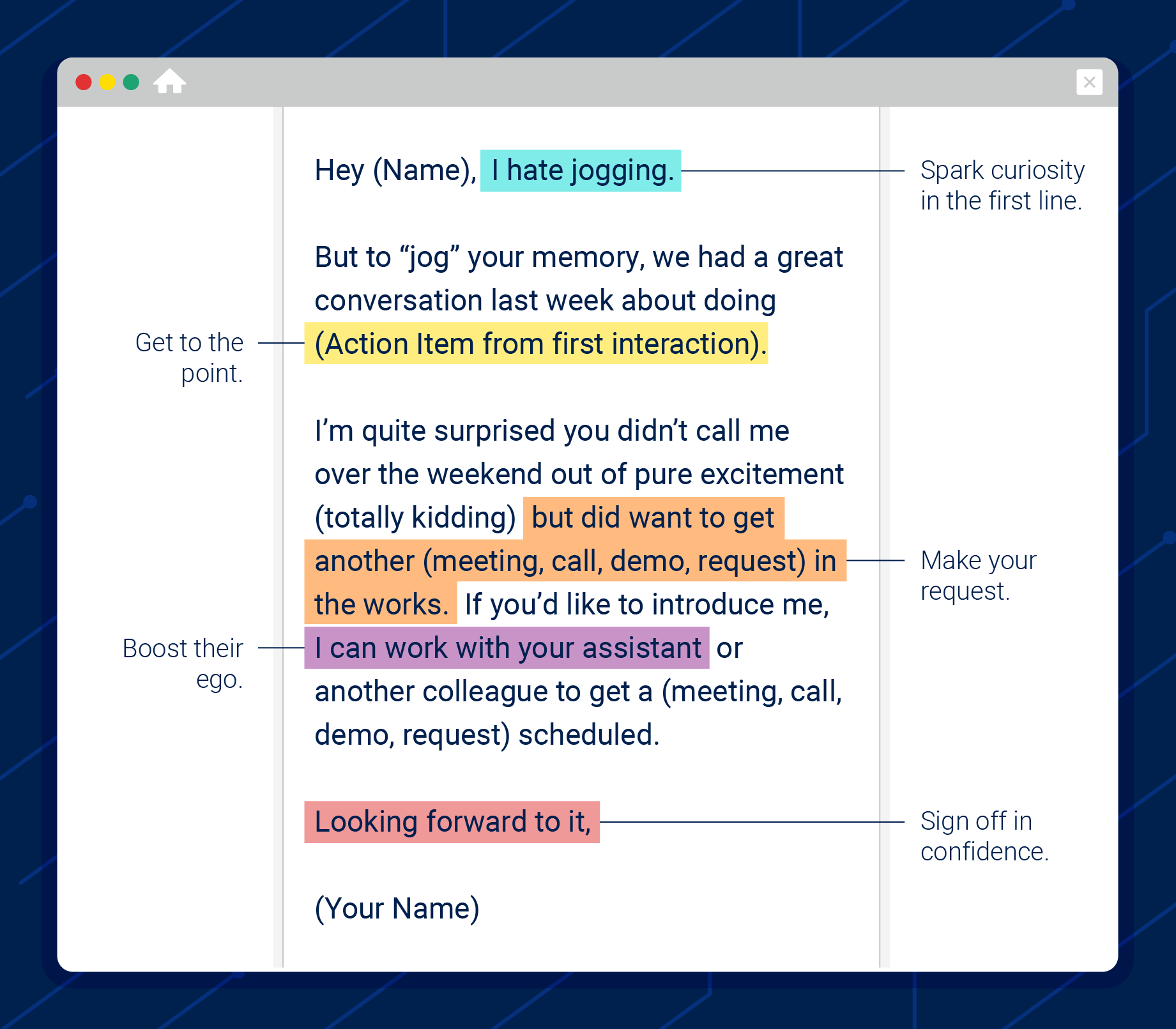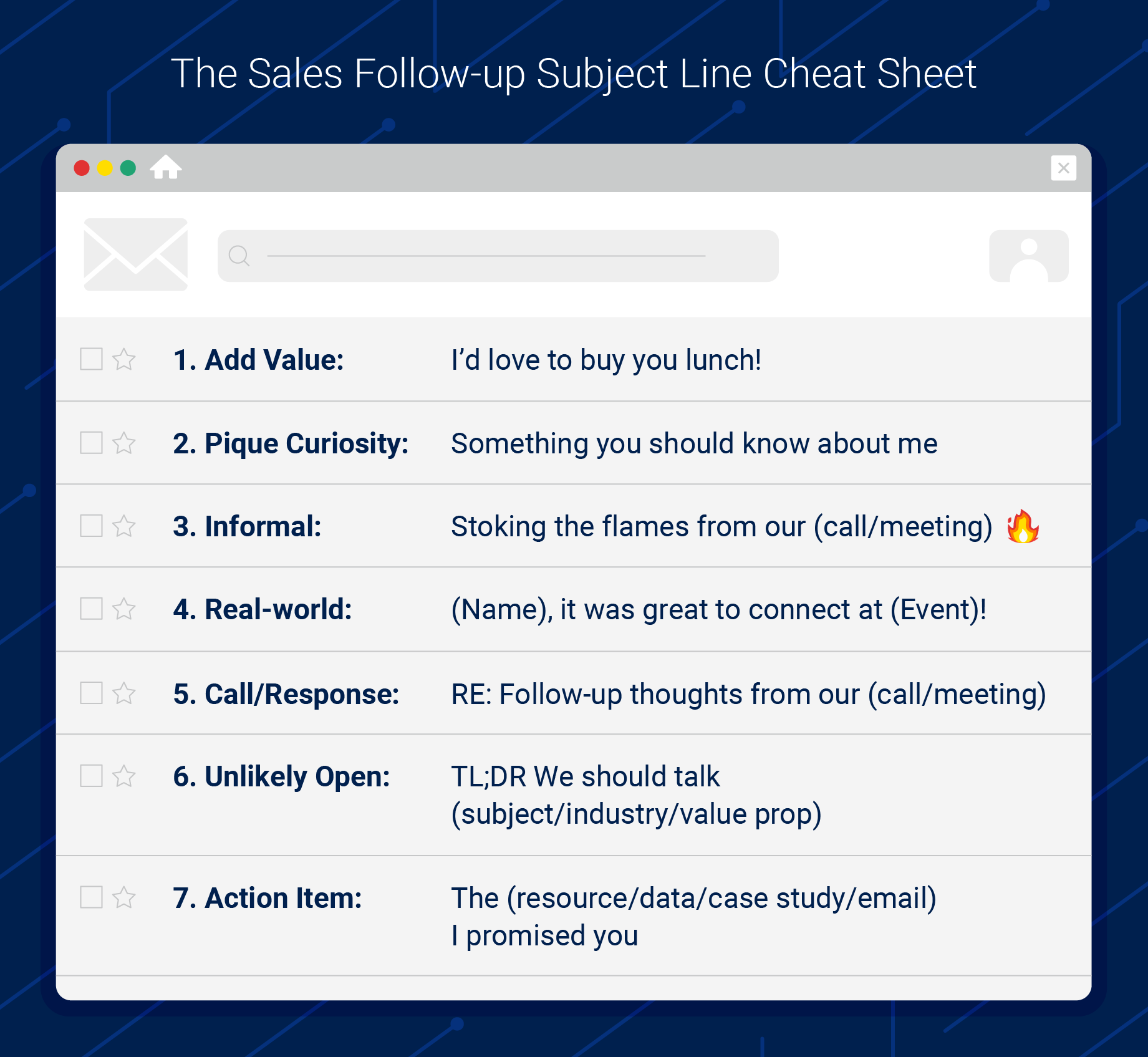Selling is like exercising—you can’t go to the gym once and expect to see results.
Similarly, you can’t contact an opportunity one time and expect to close the deal. In fact, data shows that the average closed-won deal had 70 outbound emails, compared to closed-lost deals with only 53 outbound emails.
If you’ve sent email #1 and are looking for ideas to get to 2 through 70, we’ve compiled tips and templates to guide your process.
Sales Follow-Up Email Template
When thinking about general email best practices, there are a few structural things to consider:
- Subject line length: The email inbox dashboard/service provider will truncate the subject line after 87 characters.
- Featured snippet: If the subject line isn’t too long, some text from the email body will be visible without the recipient having to open the email.
- Body length: Follow-up emails are typically sent to people who have been too busy to take the desired action. Providing a concise and easily scannable email is essential.
With these considerations in mind, we’ve provided a general overview of how your follow-up emails should be structured:

Hi (Name), (Interesting tidbit from previous conversation).
(Short paragraph, 2 sentences in length, with your main value proposition and next step request).
(If applicable, add a secondary request such as asking for a referral).
(Personalized salutation),
[Your informative email signature]
Email signatures provide a valuable opportunity to include details such as your contact information, time zone, enablement content, or even a link to your calendar. This gives the recipient resources they can use to take immediate action on your email.
How to Follow-Up After No Response
If you don’t get a response to your first email, resending the exact email can be the wrong move for many reasons.
Simply forwarding your initial email can have an unintended attachment: sass. The recipient is likely overwhelmed with emails and “resurfacing” your previous message only adds to their frustration. Not to mention your email will be displayed in the dreaded purple text in Gmail, indicating that this is information they’ve already seen.
Even if your content is mostly the same, drafting a new message is vital. Here are a few tips for writing great follow-up emails:
1. Spark curiosity
We mentioned that most email providers feature a snippet from the email body, giving the recipient some insight into what the message is about. In addition to your subject line, which should spark enough curiosity to get the email opened, your first line is another chance to engage the audience.
2. Get to the point
Your email doesn’t need a preface, preamble, or pre-anything.
Most people make the mistake of trying to explain in great detail what inspired them to send the email instead of their intended outcome or end goal. Keep it short and simple while still being informative, engaging, and actionable.
3. Make your request
There are multiple ways to boost the likelihood of your prospect taking the action you desire from a follow-up email. One prerequisite is to make sure your ask is crystal clear. This can be done with a little redundancy—making the same request in two different ways.
For example, if your goal is to get a prospect on the phone, you could say, “We should have a short 15-minute call to discuss” and then follow up with the direct question, “Are you free for a call tomorrow at 10am EST?”
4. Stroke the ego
Unless your prospect moonlights as a monk, they’ll likely be more than willing to accept a head nod to their position of power in the deal, even if gratuitous.
This also brings up a counterpoint to be aware of and cautiously avoid: not to diminish anything they’ve done, even if it’s been wholly ineffective.
For example, if your product or service replaces an initiative they’ve put lots of time and effort into, it would be best to approach the discussion from a place of respect and acknowledgment of what’s been done instead of tearing down their work to make your product or service seem superior.
5. Exude confidence
Recency bias argues that we tend to remember the information we’ve heard most recently. The final words and sentiment of your email can have a lasting impression, even if subconscious. A shaky and uncertain closing can leave the prospect feeling unsure of what to do next.

Referral Follow Up
One of the easiest ways to have a successful follow-up email is to ask for a referral to someone else in the prospect’s company or elsewhere that could be a better fit.
If they give you a name and perhaps an email address (although there are apps for finding those if not) you can send an email with the mutual connection’s name in the subject line. Leveraging this name recognition is more likely to warrant an email open, if not a response and potential relationship.
Follow-up Sales Email Subject Line Tips
The subject line is like a billboard on the side of the freeway advertising something at an upcoming exit; you have mere seconds to grab the reader’s attention and compel them to take the metaphoric fork in the road.
There are a few techniques you can deploy to make your subject lines more intriguing and engaging.
1. Add Value
When following up, a great subject line could be a reference to something about the prospect that was revealed or something you were unsure about. If you happened to hear the name of their favorite restaurant or sports team, offer to take them out for a meal or go to a game.
If there were any unanswered questions or resources discussed, a follow-up email containing the answers is a highly valuable way to keep the conversation going.
Value-Add Subject Line Examples
- I’d love to buy you lunch!
- Tickets to the [Team] game
- I made a video for you
2. Start with “Re:”
Prepending your subject line with “Re:” is a way to make your email immediately stand out as a follow-up and not a cold email. This is because in most cases, email providers will automatically prepend replies with a “Re:” in the subject line.
“Re” is also literally defined as “in the matter of” which works well if you follow it up with the next tip.
Re: Subject Line Examples
- Re: Did you review our proposal?
- Re: Budget constraints/pricing
- Re: [Their name] <> [Your name]
3. Give the TL;DR
In case you don’t know, “TL;DR” stands for “too long; didn’t read.” Unfortunately, this is exactly what most recipients use the subject line for, so it’s better to actually provide them with intriguing information.
If you don’t think the recipient will open your email (perhaps the first email went unopened), use this one opportunity to make your request abundantly clear.
TL;DR Subject Line Examples
- TL;DR we should talk [subject, industry, value prop]
- TL;DR meeting tomorrow @ 2pm ET
- Question about our upcoming call
4. Include an Action Item
Closing the loop on something that was previously discussed or even mentioned in passing is a great way to follow up without being intrusive. When follow-up emails serve no purpose other than to nag someone to respond, they will likely be given even less attention than the first email.
When a reference is made to an action item from your first interaction, however, providing more information or context can be a great way to add value and give your email a greater purpose.
Action Item Subject Line Examples
- That [resource] I promised you
- The info you requested
- Kickoff date/time options discussed
Example Follow-up Subject Lines
Everyone loves a free lunch, so much so that I hyperlinked that to our home page…did you click out of curiosity?
As you navigate your life in the inbox, stop and observe the next time you open an email from someone you don’t know; What made you open it? Test out a similar strategy in your follow-ups.

How Long Should You Wait to Follow Up?
5 Business Days.
Here’s some back-of-the-envelope math to support this grey area in sales.
Even if the average inbox receives only 10–15 emails per day (I don’t know about yours, but mine gets many more than that), then it’s likely that your email will be buried in their inbox after 3 to 5 days, because most inboxes show the 50 most recent emails.
There’s also the forgetting curve, which suggests the prospect has all but forgotten your first point of contact at the 5-day mark.
From Follow-Up to Closed-Won
Opportunity management is one of the most crucial components of any sales team, inbound or outbound. Effectively tracking and guiding opportunities through the pipeline to closed-won can be tedious and time-consuming, but with PeopleGlass by People.ai, you have a simplified command center for updating your CRM.
PeopleGlass transforms the often complex and cumbersome Salesforce experience into a spreadsheet-like app, allowing for efficient updates like scheduling follow-ups and next steps. Best of all, you can get started for free.



